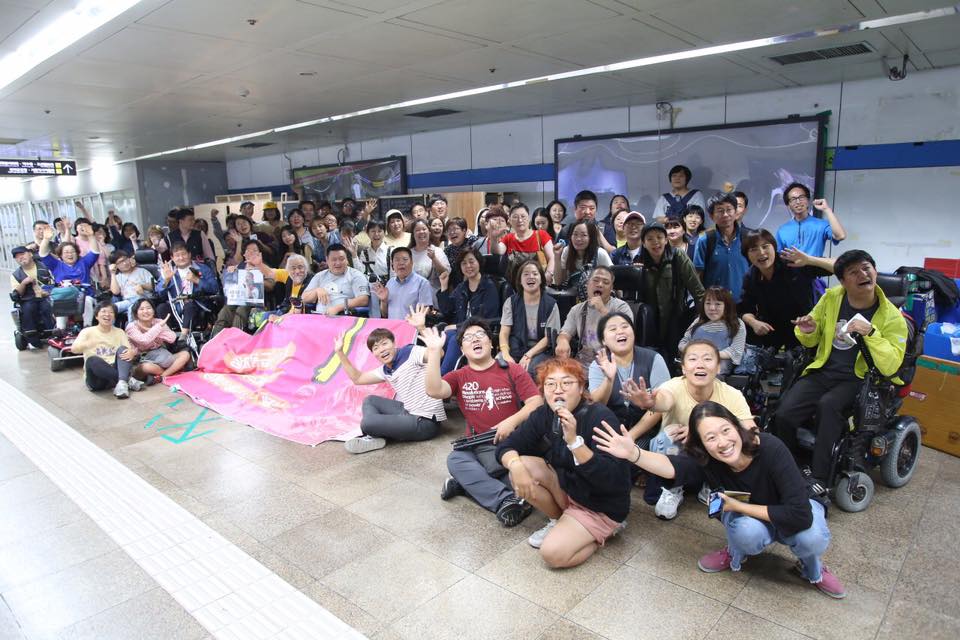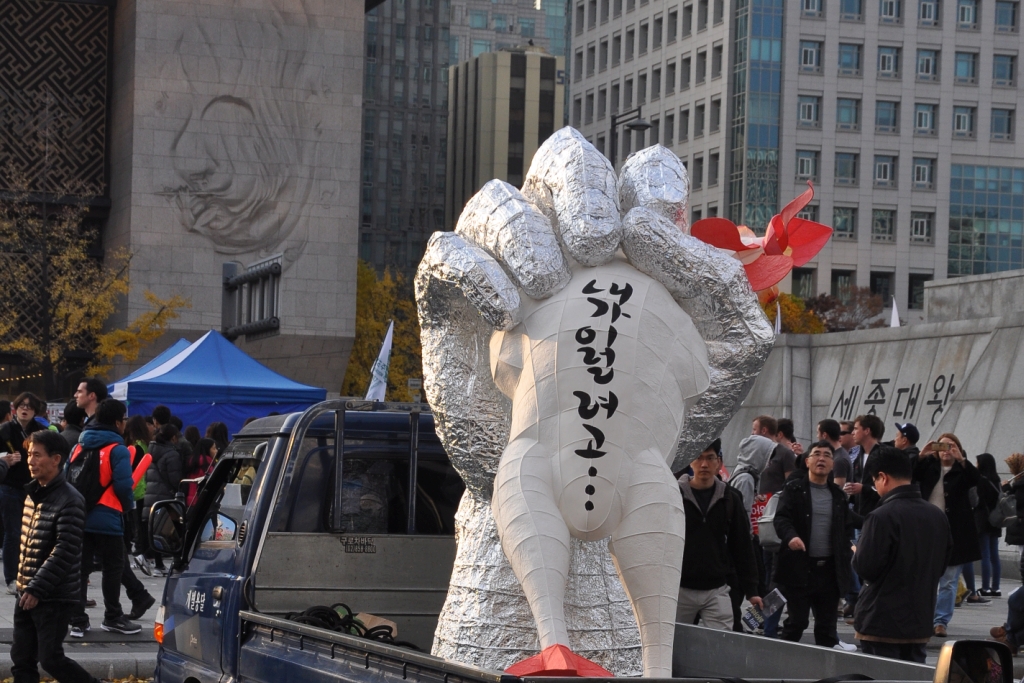
A Small Victory for South Korea's Disability Rights
On a cold winter evening in 2012, Lee Hyung-sook came out to Gwanghwamun, a historic square in central Seoul, to catch the attention of then-candidate Park Geun-hye. Lee uses a wheelchair to get around and is officially classified as “level 1,” a grade applied to the most severely handicapped South Koreans.
Lee came to the campaign event holding signs calling for better rights for the disabled, a cause Park publicly supported. Then, much to Lee’s shock, she was violently set upon by Park supporters, who thought that the mere presence of a disabled person would be bad for Park’s campaign. “Some of the elderly voters started hitting me, saying, ‘What are you doing here? You’re damaging Park’s campaign,’” Lee said.
Roughly five percent of South Korea’s 51.7 million people are registered as having a disability. But, as in many other societies, disability is too often considered synonymous with abnormality and defect, a shameful blemish that must be hidden from sight — Lee’s story being one of the more extreme cases.
A perversely comedic twist is that Lee’s own mother, in her eighties, is a fervent Park Geun-hye supporter. “The seniors that hit me were old like my mother,” Lee said. She didn’t tell her mom the details of the beating, which she managed to escape with a few bruises.
“I knew then that Park Geun-hye was going to win,” she laughed. “Her supporters were so scary and so formidable.”
At the time, Lee was just a few months into a sit-in inside Gwanghwamun subway station, just below the square. She was part of a group of activists demanding better rights for disabled people.
She couldn’t have known this in 2012, but the demonstration would last five years, throughout Park’s truncated presidency and well into her ongoing detention. Lee, as one of the sit-in’s leading activists, would ensure that the activists had a 24/7 presence in the space and the monthly fines were duly paid to the subway station (for illegally occupying the space).
The sit-in, organized by a network of groups fighting for disability rights, came to represent South Korea’s most prominent case of disabled activism (though that’s not necessarily saying much). More often than not, their cause was met with indifference, especially in its initial years. Right above them, at ground level, were the Sewol protesters, engaged in a prolonged (and more prominent) sit-in of their own.

The Sewol ferry sank on Apr. 16, 2014, killing over 300 people, mostly students from a high school in Ansan. Just one day later, 52-year-old Song Guk-hyun died from burn wounds. When a fire started in his home, he had been unable to escape in his wheelchair.
Despite activists’ efforts, Song’s death was overshadowed by the media frenzy surrounding the Sewol. Lee and other activists argue that his death was caused by the government’s method of grading disabled people, a centralized system unique to South Korea and a handful of other countries, including Japan.
“Song was institutionalized for 26 years and had hemiparalysis,” Lee said. “He could use the left side of his body but not the right. He could wash rice but couldn’t carry the rice bowl. He needed help.”
But he wasn’t eligible to get a personal assistant because his disability rating was level 3 (levels 2 and 1 are eligible).
The wrong level
When the grading system was first implemented in 1988, Lee Hyung-sook was in her early twenties. “I opposed this system from the beginning,” Lee said. “Why classify a human being like this?”
Nevertheless, she went to the hospital to get a diagnostic report for registration. She remembers the doctor asking, “Which level do you want?”
In South Korea, people with disabilities can apply for six levels of disability, which correspond to different levels of government assistance and benefits. The levels are decided by the National Pension Service based on strictly medical criteria.
“I thought people wouldn’t look at me positively if I was level 1,” Lee said. “So I asked the doctor for a 3.” He gave it to her. Many years later, she reapplied to receive level 1 — through a more rigorous medical process than the one in 1988 — and was accepted.
“It sounds like a beautiful system from the bureaucratic point of view, with the appearance of equitability, but I would question if it really is equitable,” said Trevor Parmenter, an honorary professor at Sydney University and a contributor to the 2011 World Disability Report.
“The system rests entirely upon medical assessment,” Parmenter said. He pointed out that the WHO classification includes environmental factors. External conditions play a crucial role in assessing disability. For example, someone with a “level 3” handicap would likely need more assistance if living in a rural area than someone living in Seoul with the same impairment.
“It’s an oversimplification of disability,” said Parmenter, referring to South Korea’s classification approach.
Jeong Sun-gil, a spokesperson for the Disability Policy department at the Ministry of Health, admitted that the medical assessment had limitations. “That alone doesn’t factor in which specific services individuals with disabilities need,” he said in an email.
Lee argues that the deaths of many, including that of Song Guk-hyun in the fire, are caused by this faulty system. For the past five years, she has demanded the government abolish the classification, and create a way for individuals to get more customized services. During the presidential campaign, Park Geun-hye had promised to abolish the system. It turned out to be an empty promise.

Out in the world
Lee Hyung-sook, now 50, has no memory of using her legs. She fell ill with polio at age three. She rides around in an electric wheelchair; the bottoms of her two-year-old leather shoes are like new, but the fronts are worn from bumping into elevator doors, walls and other surfaces.

I visited her on the 1,807th day of the sit-in, just a few months before it ended. I have been to Gwanghwamun Square numerous times to cover the Sewol protests and visit government ministries.
I’d often step out of the subway, see the sit-in near the exit, and wonder why the booths looked so worn and permanent. Then I’d walk past, like other Seoulites.
“We said we were being foolish,” Lee said, recalling the first year in 2012. “We thought, let’s at least raise awareness about our cause. Who knows if it’s going to last five years, or ten.”
In addition to the classification system, the activists want to abolish a law that limits those with low income — including many disabled people — from receiving government subsidies based on their family members’ income (in such cases people can be denied benefits because they have relatives who earn money, even if those relatives don’t support them).
They also want to get rid of facilities that house and care for disabled people. Lee calls these institutions “concentration camps.”
She argues that the facilities, which currently house over 30,000 people, most of whom have severe impairments, segregate people from the rest of society and perpetuate the perception of abnormality. They’re tainted by human rights violations, according to government reports, which often go unnoticed.
“There are around 4,000 on the waiting list for our facilities,” said Jung Hyun-suk, a manager at the policy support office of the KAWID, a network of over 700 facilities, all of which are free, save some monthly expenses.
“Around 70 percent of the applications come from family members, rarely from disabled people themselves. 80 percent of our residents have mental illnesses and are unable to live alone. Unfortunately, what the activists are demanding conflicts with the families’ opinions.”
Hong Yunhui, whose 11-year-old daughter is in a wheelchair (but not institutionalized), agreed. “I think both sides are reasonable. But there’s definitely a need for these facilities. I’m lucky enough to get enough help to still go to work, but some people lose their personal lives taking care of disabled family members.”
According to Jung, what makes it harder to get rid of facilities is the lack of infrastructure for disabled people in the outside world. Housing, employment, transportation — none of these cater sufficiently to people with physical and mental handicaps.
“Disabled people don’t go out much because it’s so inconvenient,” said Hong. “South Korean roads are often hilly. My daughter doesn’t have the freedom to see the wider world beyond our apartment complex. She can’t cross that big road outside.”
1,842 days
On Sep. 5, the activists in Gwanghwamun Station officially ended their sit-in, after 1,842 days underground. The Moon Jae-in administration promised to meet their demands, including abolishing the classification system.

It was a triumphant, but fleeting, moment.
Later that very evening, many residents in Seoul’s Gangseo district united in opposition to the parents of children with disabilities. The latter wanted a customized school built for their children in Gangseo; the former were afraid that a “disabled school” would tarnish the district’s reputation and its real estate value. “Stop with the theatrics,” the residents shouted at the parents, who pleaded that their children shouldn’t have to commute to schools in other faraway districts.
After five years, the activists have happily vacated their corner in Gwanghwamun station. The sit-in is over, but the story is not. The kind of world that Lee and her colleagues want — one free of prejudice towards disabled people, one that does not brand disability as inferiority — is still not here.
Hyeyoon Choi and Sydney Chun, participants at KÉ Journalism School, contributed to reporting.
Cover image: Activists officially ended their five-year sit-in on Sep. 5, 2017. (Source: SADD)
*
Read about the story of a mother who is trying to make public transportation more convenient for her disabled daughter:

